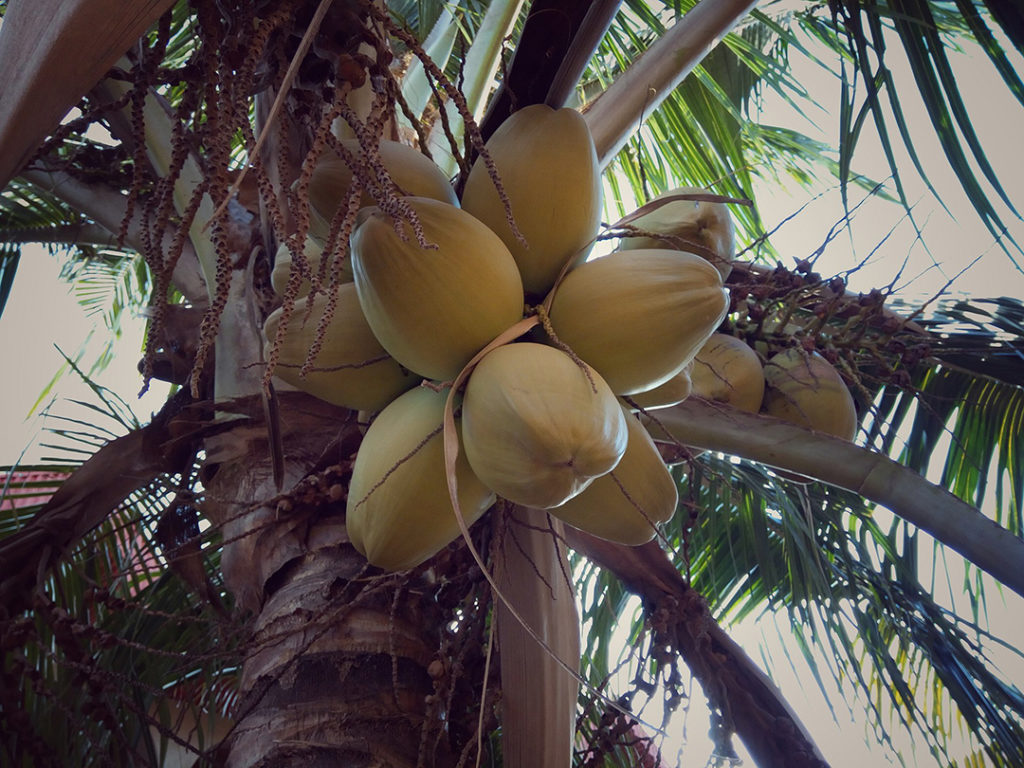
Congo, Democratic Republic of (Congo-Kinshasa)
Coconut
Cocos nucifera

General Description / Cultural Significance
The coconut palm, a tall and curving erect tree of the Arecaceae family, or Cocos nucifera, is native to the Democratic Republic of Congo and culturally significant to the people who live there. Because of its wide range of uses, it is a plant that provides for them in almost all aspects of their lives. Of course, the coconut meat and juice are popular and refreshing, and are widely enjoyed by the Congolese. The meat is eaten either raw or cooked. Special wine can also be made from Cocos nucifera. Coconut is used in traditional medicine, as the seed oil can help to treat stiff joints and the root can treat stomach problems. The oil can be used to make soap, detergents, and cosmetics. The wood is sometimes used to construct house frameworks and furniture. Many items, including brooms, are also built with coconut palms.
Climate Change/Conservation Status
The Democratic Republic of Congo is known as one of the most difficult places to live. Political instability and hunger have made it difficult for people to live there, and climate change only exacerbates those existing problems. Though the Democratic Republic of Congo does not release a high amount of carbon emissions, the people who live there feel the effects of climate change more intensely and disproportionately. Temperatures are inhospitable and natural disasters are on the rise. Rainfall patterns are changing, in addition to the challenge of food insecurity and water insecurity. The majority of people work in agriculture—up to 70%—so the inability to grow food, including Cocos nucifera, means people are not only hungry, but trapped in poverty. The most vulnerable region is called the Great Lakes region, which is densely populated and located along the country’s eastern border.
Jeffrey Gettleman, East Africa Bureau Chief for The New York Times, stated that the Congo has become a never-ending nightmare, one of the bloodiest conflicts since World War II. There are more than five million people dead, and it seems incomprehensible that the biggest country in sub-Saharan Africa and one of the richest on paper—with copper, diamonds, gold, vast fertile farmlands, and enough hydropower to light up the continent—is one of the poorest and most hopeless nations on earth. This conflict has disturbed ecosystems, and affected the country’s development.
In 2017 it was reported that the country was on the brink of famine with an estimated 7.7 million people needing food aid. The crisis is worsening due to the ongoing violence in the Kasai and Tanganyika regions that has forced 1.4 million people to flee their communities. Other contributing challenges for crops include a veracious crop-eating caterpillar, and outbreaks of cholera and measles that have only worsened this humanitarian crisis.
Alternate Names
Coconut palm
Coconut tree
Sources
Columbia Climate School, n.d. IRI Project Feature: Climate and Coconuts. Columbia Climate School The Earth Institute. [website]
Danso, G., 2019. Climate change in Africa could cost continent’s peace – Index. Ghana Business News. [website]
Government of Netherlands, 2018. Climate Change Profile Democratic Republic of the Congo (East). Ministry of Foreign Affairs of the Netherlands. [website]
Permanent Mission of the Republic of Zaire to the United Nations. This statement can be found on the World Sensorium original website.
USAID, 2018. Climate Risk Profile: Democratic Republic of Congo. US Agency for International Development. [website]

